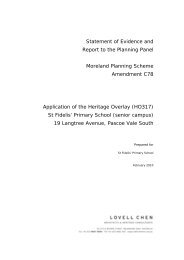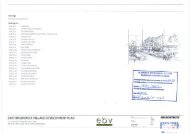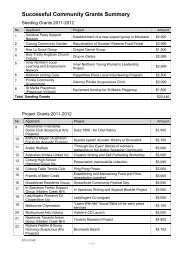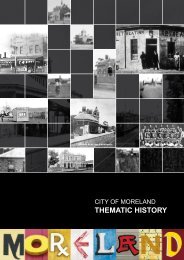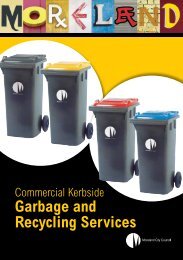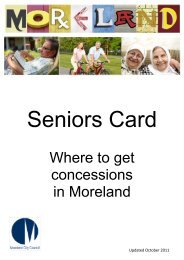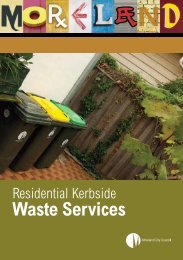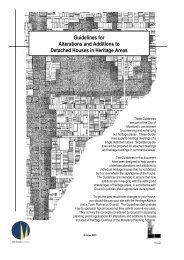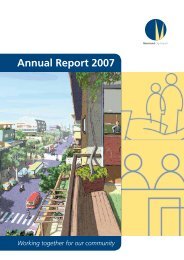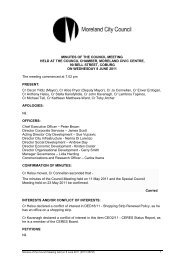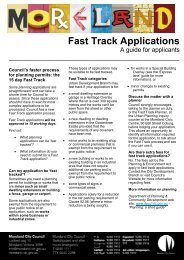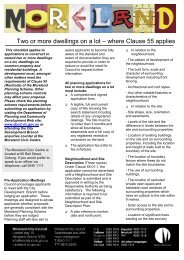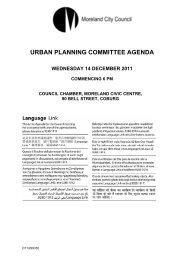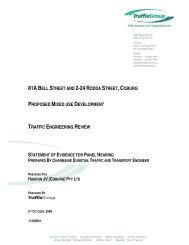Tourism Map_back.indd - Moreland City Council
Tourism Map_back.indd - Moreland City Council
Tourism Map_back.indd - Moreland City Council
You also want an ePaper? Increase the reach of your titles
YUMPU automatically turns print PDFs into web optimized ePapers that Google loves.
You won’t find anywhere like <strong>Moreland</strong> in the<br />
whole of Melbourne. Take time to explore its<br />
secrets. You’ll be surprised.<br />
Just 4.5 kms from Melbourne’s CBD, with excellent public<br />
transport links to the city, <strong>Moreland</strong> combines the urban<br />
beat of café culture, contemporary arts and music, with<br />
green parks and meandering creeks.<br />
<strong>Moreland</strong>’s history includes indigenous and European<br />
settlement, as well as industrial boom and waves of<br />
migration. <strong>Moreland</strong> hosts more than 61 community<br />
festivals and celebrations each year and, in Sydney Road,<br />
you will find one of Melbourne’s most varied shopping<br />
and eating experiences.<br />
This map features some of our favourite places reflecting<br />
<strong>Moreland</strong>’s history and its multicultural community. We’re<br />
sure you will find other hidden treasures along the way.<br />
Some of the places mentioned in this leaflet are privately<br />
owned, particularly houses, and are not open to the public.<br />
We request that you respect the privacy of the owners.<br />
<strong>Council</strong> recognises Aboriginal people as the original<br />
custodians of the land now known as the <strong>City</strong> of<br />
<strong>Moreland</strong>. Wurundjeri people, part of the Woiworung<br />
group, traditionally used the rich resources of the region<br />
and its many waterways. The ‘Merri Merri’ creek was<br />
a meeting place for the Woiworung and three other<br />
cultural language groups, for social contact, ceremonies,<br />
marriage, trade and deciding issues of customary law.<br />
A More Sustainable Future<br />
CERES 54<br />
(Centre for Education and Research in Environmental Strategies)<br />
8 Lee Street, Brunswick East (Melways 30 B7)<br />
CERES focuses on environmental and social<br />
issues affecting urban areas. The site has displays<br />
and functional demonstrations on a range of<br />
environmental issues to show what can be<br />
achieved at household, community and global<br />
levels. These include energy generation, waste re-<br />
cycling, permaculture and ways to reduce impact<br />
on the environment. There are many community<br />
projects and opportunities to get involved as<br />
a volunteer. CERES has an active education<br />
programme for all ages.<br />
Check out the following and see the CERES website for more<br />
information and opening times: http://www.ceres.org.au/<br />
• Café (open 7 days/week)<br />
• Community gardens<br />
• Permaculture gardens<br />
• Origin EcoHouse<br />
• Origin Energy Generation System, including wind generation,<br />
solar power and photovoltaics<br />
• Animal farm<br />
• Permaculture and Bushfood nursery<br />
• Multicultural village (with African and Indian cultures represented)<br />
• Indonesian village<br />
• Comprehensive display of household composting systems<br />
• Several trails, such as the Wurundjeri Wander, the 2030 Trail, the<br />
Greenhouse Trail and the Waste Wise Trail<br />
• Vermiculture and worm farm enterprise recycling organic waste<br />
• Market garden next to the Harding Street trestle bridge is run by<br />
CERES and produces organic vegetables. Now the only market<br />
garden left on Merri Creek – there were lots, many farmed by<br />
Chinese. (Melways 30 A2)<br />
WestWyck 36<br />
492 Victoria St, Brunswick West (Melways 29 D7)<br />
WestWyck is a developing “eco-village” which re-uses the building<br />
and grounds of the former Brunswick West Primary School. The<br />
project is dedicated to sustainable development and good design.<br />
Key features include:<br />
• Re-cycled building materials;<br />
• Water management and conservation measures that include the<br />
removal of hard surfaces to allow water to permeate, maximised<br />
storage and use of roof water, recycling of grey water,<br />
minimisation of water discharge from the property through the<br />
use of storm water retaining reed beds which also protect the<br />
foundations of the building;<br />
• Two underground worm farms to treat all organic waste<br />
produced on site, including some toilet wastes and three<br />
transpiration beds to deal with liquid waste;<br />
• Energy efficiency achieved through site orientation, insulation,<br />
double glazing, solar/gas hot water systems, water and energy<br />
efficient appliances; and<br />
• Generation of renewable energy through photovoltaic cells.<br />
An informative website is worth a look:<br />
http://www.westwyck.com and a visit to CERES will help you to<br />
understand the technology being used at WestWyck.<br />
See also: Sustainable Energy Authority of Victoria<br />
www.seav.vic.gov.au<br />
Brunswick West sustainable house 30<br />
19 Murray Street, Brunswick West (Melways 29 C5)<br />
A 1929 Californian Bungalow retrofitted for energy and water<br />
efficiency including solar electricty, solar hot water, rainwater<br />
tanks and water recycling, set in a permaculture garden. It was the<br />
first grid connected solar house in Victoria. The family has cut its<br />
household mains water use to just 3 buckets a day!<br />
Contact: smcquire@bigpond.net.au<br />
RMIT University Fashion and Textiles Building 46<br />
25 Dawson Street, Brunswick<br />
(Melways 29 F8/9)<br />
Designed by H2o and Bates Smart<br />
Architects, the project is significant<br />
because of its environmentally<br />
responsive design. Initiatives include<br />
the western red cedar façade which<br />
provides passive solar temperature<br />
control through its double skin as<br />
well as reflecting the woven fabric<br />
of textiles.<br />
A super-short history of European<br />
settlement<br />
When land in <strong>Moreland</strong> was first sold by the Colonial NSW<br />
government in 1839 settlers purchased large blocks of many acres.<br />
Over the years these were split into smaller blocks, then smaller<br />
blocks again and sold off. Sydney Road, once a cart track, became<br />
the main route from Melbourne to Victoria’s goldfields with shops,<br />
churches, hotels and a mechanics institute already built by the late<br />
1860s. Pentridge Village was an important focus.<br />
Pentridge Village (Coburg) 19<br />
(Melways 17 H/J 11/12)<br />
Coburg was originally called Pentridge, a name<br />
which, to most Melburnians, means a notorious<br />
high security prison. This is a long way from the<br />
government’s original vision for Pentridge when<br />
they set aside land to create a village to serve<br />
surrounding communities. The Pentridge Village<br />
Reserve was marked out between (today’s) Sydney<br />
Road to the west and Coburg Cemetery (Melways<br />
18 B12) to the east (now in the <strong>City</strong> of Darebin).<br />
Pentridge Village Reserve is one of few left in Melbourne. The church<br />
and municipal reserve towards the NE of the Sydney Road and Bell<br />
Street intersection were built early in the village’s development. It<br />
has a number of civic buildings including the Uniting, Anglican and<br />
Roman Catholic Churches; Coburg Primary School; Coburg Town Hall<br />
and council offices. This is the only place in Victoria where churches of<br />
major denominations are side by side.<br />
The former Wesleyan Methodist Chapel in this complex is the<br />
oldest surviving Methodist church in Victoria. It was built 1849-50<br />
from local bluestone and imported sandstone.<br />
HM Prison Pentridge 18<br />
(Or the reason Pentridge became Coburg) (Melways 17 J11/12)<br />
Pentridge Village’s development was slow and there was plenty of<br />
land available for a prison. It was also close to Melbourne and had<br />
a good bluestone supply.<br />
The first prisoners arrived in 1850 and were locked in two rows of<br />
huts-on-wheels behind a four-feet-high stake fence. The idea was<br />
that this temporary prison could be wheeled to wherever labour<br />
was needed.<br />
A permanent prison, the largest in 19th century Victoria, was built<br />
between 1858-64. Daily life in this model prison was harsh. It was<br />
a life of hard labour, silence and isolation. Social contact was<br />
not allowed.<br />
Pentridge supplied most of the bluestone for early Melbourne<br />
and prisoners spent up to 10 hours a day locked in cramped,<br />
individual pens crushing the hard stone. At the Port Arthur<br />
convict settlement in Tasmania crushing bluestone was<br />
considered to be the worst punishment possible. At Pentridge<br />
it was an everyday task.<br />
After Pentridge was built the<br />
villagers, tired of the stigma of<br />
being associated with a gaol,<br />
tired of living with the sounds<br />
of prison life (warders firing at<br />
prisoners, a bell which rang every<br />
half hour), and tired of living<br />
in constant fear of (frequent)<br />
escapes – changed the name of<br />
the village to Coburg in honour<br />
of Queen Victoria’s husband<br />
Prince Albert, Duke of Saxe Coburg in Germany.<br />
When Melbourne Gaol closed in 1923 Pentridge became<br />
Melbourne’s main prison and the site for hangings. The<br />
remains of prisoners executed at Melbourne Gaol, including<br />
Ned Kelly, were re-buried at Pentridge. The last public hanging<br />
in Australia took place here in 1967 – Ronald Ryan.<br />
Although closed in 1997, Pentridge Prison presents an<br />
imposing reminder of the brutal regime that operated there<br />
for over 100 years. During its history, Pentridge also housed<br />
a women’s prison and children’s reformatory. Most of it<br />
survives intact. The site was sold in 1999 by the Victorian<br />
State Government and is now being privately developed into a<br />
residential, commercial and tourism precinct.<br />
Places linked with Pentridge Prison<br />
Prison warders had to live within earshot of the prison bell.<br />
The Bluestone Cottage at 82 Bell Street, Coburg, (Melways 17<br />
J12) was originally one of seven. It is now HQ of the Coburg<br />
Historical Society with a major Pentridge display area 22 .<br />
Arundel at 42 Ross Street, Coburg (Melways 17 H11) was a<br />
boarding house for warders run between 1896 and 1898 by<br />
the wife of Pentridge’s warder in charge of rosters.<br />
Coburg Lake Quarry (Melways 17 J10)<br />
Bluestone rock faces are a reminder of the time<br />
the area was used as a quarry for stone used to<br />
build the nearby Pentridge prison. Prisoners also<br />
planted the willows on the banks of the lake, to<br />
provide raw material for basket weaving.<br />
Bluestone bridges built by prisoners<br />
• Newlands Road Bridge over Merri Creek,<br />
built 1865 (Melways 17 K11)<br />
• Murray Road Bridge over Merri Creek, built<br />
1870 (Melways 18 A10/11)<br />
More Recreation and Retail Therapy<br />
Sydney Road<br />
Sydney Road did not start out as the buzzing thoroughfare it is<br />
today; it began as an access track to farming allotments. Then<br />
gold rush mania turned the road into the path to riches and<br />
things got busier. Substantial hotels and stores with supplies<br />
for the goldfields sprang up quickly.<br />
By the early twentieth century Sydney Road<br />
was one of the busiest in the city and, today,<br />
it is certainly the most exciting… think<br />
international bazaar; middle Eastern souk;<br />
belly-dancing, Mediterranean outdoor market;<br />
an international fashion show and, last but not<br />
least, a place you can find more bargains than<br />
you can imagine.<br />
Take the tram, make lots of stops, and savour<br />
the sounds, smells and tastes of this dynamic<br />
street – one minute you’re in Greece – take a<br />
few steps and you have arrived in Lebanon…<br />
another and you are in Morocco, Turkey, Italy,<br />
China, India … take time to explore; a round<br />
world trip without the air ticket!<br />
Look out for these retail landmarks:<br />
Bates Building 23<br />
400-404 Sydney Road, Coburg (Melways 29 G8)<br />
Built in 1866 for Henry Bates a carrier, the ground floor<br />
first included stables and small shops. Upstairs there was a<br />
roller skating rink, which became a dance hall in the 1930s<br />
displaying striking mural decorations of the Taj Mahal Dance<br />
Club (limited viewing, mainly in December).<br />
Brunswick Market 40<br />
1-9 Ballarat Street, Brunswick (Melways 29 G7)<br />
This former market, now converted into flats and houses, was<br />
Melbourne’s first self-service grocery store run by Geelong<br />
supermarket pioneer S E Dickens. Melbourne wasn’t ready and<br />
it closed in 1915. Today the site links to Sydney Road through<br />
Sparta Place, a pedestrian piazza which celebrates <strong>Moreland</strong>’s<br />
Greek ties and sister city relationship with Sparta. Lighting<br />
enhances the market buildings at night.<br />
Hooper’s Store 41<br />
463-475 Sydney Road, Brunswick (Melways 29 G7)<br />
Opened in 1908 Hooper & Co was a leading 19th century<br />
draper with Hoopers running it until 1935. Hooper’s Store is an<br />
American-style steel framed building designed by the architects<br />
of Melbourne’s Myer department store, HW and FB Tompkins.<br />
Recently taken over by Melbourne couturier Mariana Hardwick.<br />
Former <strong>Map</strong>les Store 42<br />
466 Sydney Road, Brunswick (Melways 29 G7)<br />
One of a group of five gothic style commercial buildings, it<br />
has been a bank, part of the <strong>Map</strong>les chain and now a Franco<br />
Cozzo furniture outlet.<br />
For more Sydney Road gems follow Historic Sydney Road:<br />
Brunswick and Coburg, a brochure by Brunswick Community<br />
History Group and Coburg Historical Society.<br />
Lygon Street<br />
The café culture in Lygon<br />
Street is hip and bohemian. It’s<br />
multicultural, it’s lively, it’s the<br />
place to be (seen). You’ll find<br />
patisseries and bakeries with<br />
treats from every country you<br />
can think of. There are also<br />
cafes, bars, fruit and health food<br />
shops and locally made gelati.<br />
More Bargains<br />
<strong>Moreland</strong> is the home of bargain shopping. Clothing, textiles,<br />
shoes, leather goods, food, furniture, manchester, sports,<br />
electrical… plan your tour by checking out these websites:<br />
Factory outlets in <strong>Moreland</strong>:<br />
http://www.moreland.vic.gov.au/business/factoryoutlets-fr.htm<br />
Shopping centres in <strong>Moreland</strong>:<br />
http://www.moreland.vic.gov.au/business/retailcentres-fr.htm<br />
Bargain Shopping website:<br />
http://www.bargainshopper.com.au<br />
More Parks and Open Spaces<br />
<strong>Moreland</strong> has a surprising diversity of open spaces, many built<br />
over former clay pits or quarries. The creeks offer major green<br />
respites from the built up areas and include recreation facilities,<br />
BBQs and public art. Excellent pedestrian and bike access.<br />
Moonee Ponds Creek<br />
Once a tranquil meandering chain of deep ponds and<br />
wetlands, but deemed by the former Melbourne Metropolitan<br />
Board of Works as ‘unstable’ and subject to flooding, the creek<br />
was re-aligned and partially concreted with the building of the<br />
Tullamarine Freeway. The junction of works is located just north<br />
of Ethel Street, Oak Park where the divergent engineering<br />
treatments are most obvious (Melways 16 G7) 8 .<br />
Jacana Retarding Basin, Glenroy<br />
(Melways 6 E12)<br />
A major wetlands site shared between<br />
<strong>Moreland</strong> and Hume with abundant birds and<br />
wildlife and flood control mechanisms with<br />
a sci-fi appearance. Some of the best views<br />
towards the Melbourne skyline. Access from Moonee Boulevard.<br />
There are unexpected hilly landscapes in the northwest reaches,<br />
including a huge timber trestle bridge (1924) cutting across Kingsford<br />
Smith Ulm Reserve (Melways 16 F7 & G7).<br />
Oak Park Reserve 7<br />
26 Josephine Street, Oak Park (Melways 16 G6)<br />
A small reserve with mature trees, part of the estate of the 1840<br />
homestead ‘Bell Vue Park’ owned by John Pascoe Fawkner. An oak<br />
tree, believed to be planted by Mrs Fawkner, is registered by the<br />
National Trust.<br />
Union Street, Brunswick West (Melways 29 B8/9)<br />
Significant crescent of remnant vegetation along creek, western end<br />
of Union Street.<br />
Merri Creek<br />
Interpretive signage from Fawkner to Brunswick.<br />
Moomba Park and Moomba rocks, Fawkner 5<br />
(Melways 7 J/K 11; 8 A11 & 12)<br />
Open grassy plains with long views <strong>back</strong> towards city<br />
skylines. Majestic basalt outcrop on escarpment<br />
Jukes Road Grasslands 6<br />
(Melways 18 A1 & 2; B1 & 2)<br />
Nationally and regionally significant remnant grassland species.<br />
Coburg Lake Reserve (Melways 17 J10)<br />
A major recreation area for people in the northern<br />
suburbs, renowned for swimming and picnic facilities<br />
from the early 20th century. See the fish ladder close<br />
to the Newlands Road Bridge, which enables fish to<br />
swim upstream.<br />
More open space…<br />
Westbreen Creek Parklands (Melways 17 A6-8)<br />
An undulating linear park, home to many species of birds and<br />
animals.<br />
Bain Reserve, Merlynston 10 (Melways 17 G6)<br />
Merlynston is <strong>Moreland</strong>’s secret village set around<br />
a green, Bain Reserve, and recent prize-winning<br />
boardwalk. Developer Stuart Bain envisaged<br />
Merlynston as the ‘Toorak of the North’ when<br />
he bought the land in 1919. Note the line of<br />
prefabricated ‘snail’ houses along Lorenson Avenue.<br />
Clifton Park, Brunswick 38 (Melways 29 E7-F7)<br />
<strong>Moreland</strong>’s festival park.<br />
Temple Park, Brunswick 50 (Melways 29 E9-F9)<br />
Home to Brunswick Trugo Club. Trugo, a mix of bowling and croquet,<br />
started out in the 1920s as a game played by railway workers in the<br />
Newport rail yards and has a loyal following in Victoria.<br />
Randazzo Park, Brunswick 47 (Melways 29 H8)<br />
Australian Institute of Landscape Architects award<br />
winning urban park (2002).<br />
Methven Park precinct, Brunswick East 53<br />
(Melways 29 K8)<br />
Development from farmland to basalt stone quarry<br />
to council tip to public park. Historically significant<br />
for elm avenues and original path pattern. Note<br />
nearby 32 Lord Street which served as a synagogue<br />
and Sabbath School between 1942-1987.<br />
More than a clothes line and a wine<br />
cask (Industrial <strong>Moreland</strong>)<br />
Did you know that Australians invented the clothes line and wine<br />
cask? <strong>Moreland</strong>’s claim to fame is that it is the home of brick veneer<br />
and the birthplace of the cream brick fashion of 1960s Melbourne –<br />
see the earliest experiment in the use of cream brick (from Hoffman’s)<br />
on the spire of the Presbyterian church in Sydney Road 51 .<br />
And there’s more… <strong>Moreland</strong> provided most of the bluestone for<br />
Melbourne from its quarries and most of the bricks for the 1880s<br />
building boom from its numerous brick works.<br />
<strong>Moreland</strong> used to be a major textile, clothing and footwear<br />
manufacturer in Australia but continues to feel the impact of<br />
reduction of tariff protection. Many former factories are being<br />
converted into apartments.<br />
Brick making and potteries<br />
<strong>Moreland</strong> is an area rich in clay suitable for brick making. In the early<br />
19th century, chimneys dominated the skyline and clay pits peppered<br />
the landscape. Today, the clay holes are filled in and Hoffman’s<br />
towering chimneys stand alone.<br />
Hoffman’s Brick and Pottery Works 44<br />
72-106 Dawson Street, Brunswick (Melways 29 E8)<br />
Hoffman’s, named after the German-designed Hoffman brick kiln,<br />
was the largest pottery in Victoria operating from 1870-1969.<br />
Hoffman’s use of steam brick presses marked the change from<br />
small to large-scale brick making in Australia. The brickwork’s vast<br />
output supplied Melbourne’s builders during the 1880s boom. Other<br />
products included pipes, roofing tiles, jelly moulds, ginger beer<br />
bottles and spittoons.<br />
You can see the chimneys and two remaining brick kilns from the<br />
street and Hoffman company cottages in Munro Street (Melways<br />
29 E8 & F8). The site has been re-developed with town houses and<br />
apartments and there are plans for restaurants, entertainment and an<br />
art gallery in the old Hoffman’s buildings.<br />
Two leaflets: Brickworks and Potteries Walk and Phillipstown History<br />
Walk by Brunswick Community History Group, are available from<br />
Brunswick Library.<br />
Clothing and More<br />
The extension of the railway line into Brunswick and Coburg was<br />
good for local business. New businesses included textiles, rope<br />
making, baking, can making, paper mills and engineering. You can<br />
see evidence of these industries all over <strong>Moreland</strong>. We have picked<br />
some highlights… look out for more.<br />
Lincoln Knitting Mills 14<br />
82-92 Gaffney Street through to Charles<br />
Street, Coburg (Melways 17 E10)<br />
When built in 1919 Lincoln Mills was<br />
on the edge of Melbourne- but not for<br />
long as the area around Gaffney Street<br />
became the heart of Coburg’s textile<br />
manufacturing. Other notable factories<br />
included Anderson’s hosiery and Kaora<br />
Weaving Mills. Lincoln Mills made sports<br />
coats, sweaters, hosiery, vests and<br />
underwear. Lincoln Mills closed in 1980.<br />
Kodak 15<br />
173-199 Elizabeth Street, Coburg (Melways 18 B8/9)<br />
Kodak initially operated in Abbotsford, then moved to Coburg after<br />
WW2. Prime Minister Sir Robert Menzies officially opened the new<br />
plant in 1961 when the Kodak empire was at the height of its global<br />
influence. Spread over 27 hectares the Coburg complex was one of<br />
nine major Kodak manufacturing plants worldwide. Kodak became<br />
a major local employer. Closed in 2004 mainly because of the impact<br />
of digital photography.<br />
Downs & Sons Rope and Cordage Works (also known as<br />
Sampson Cordage Works) 34<br />
64-72 Tinning Street and 7-9 Cassells Road, Brunswick (Melways 29 G5)<br />
Downs Cordage Works is the only surviving rope works in Brunswick.<br />
Established in 1888 by A.C.Downs, from Hull in England, the<br />
company is now called Donaghy’s Industries.<br />
Gas Retort House<br />
21 Hope Street, Brunswick (Melways 29 G6)<br />
The Brunswick Gas and Coke Company operated here between<br />
1891-1904 providing gas for the lighting of Brunswick’s streets.<br />
The site was later occupied by a procession of gas appliance<br />
manufacturers including the Lux Foundry and Chef. Of the<br />
original gasworks complex, only the retort house remains. It<br />
created gas by the firing of coal at high temperatures relying<br />
on the rail line for the transport of coal. Believed to be the last<br />
example of a retort house in Victoria.<br />
MacRobertson Liquorice Factory Chimney<br />
and Fire Tunnel Remains<br />
342-348 Victoria Street, Brunswick<br />
(Melways 29 G7)<br />
The octagonal brick chimney is a local landmark<br />
and summons memories of the liquorice aroma<br />
which once filled nearby streets. Part of the site is a<br />
chocolate factory. Breathe in!<br />
Henderson’s Shirt Factory 58<br />
337-339 Brunswick Road, Brunswick (Melways 29 F10)<br />
Hendersons was one of Brunswick’s earliest clothing manufacturers<br />
(1915-early 1970s).<br />
Living in <strong>Moreland</strong><br />
<strong>Moreland</strong> has examples of bluestone homes for the wealthy and<br />
the workers; of prefabricated ‘kit’ houses; of revolutionary public<br />
housing and of contemporary sustainable housing.<br />
Kit houses were assembled in both the19th and 20th century, an<br />
ingenious response to housing and materials shortages.<br />
Merlynston Snail Houses 10<br />
Lorenson Avenue, Coburg North (Melways 17 G6/7)<br />
Victorian Railways imported these pre-cut houses for<br />
workers from England when building materials were<br />
scarce in Australia after WW2. Merlynston has one<br />
of the largest remaining clusters of ‘snail houses’ in<br />
Victoria- along Lorenson Avenue. Some can also be found in Dale<br />
Ave, Pascoe Vale (Melways 17 B10).<br />
The Beaufort House, Pascoe Vale South 16<br />
(Melways 17 B12 & 29 B1)<br />
Made from metal sheeting panels and bolted<br />
together. Designed in 1946 by technical staff from<br />
the Beaufort Bomber plant at the Department of<br />
Aircraft Production at Fisherman’s Bend. Assembled<br />
by the Housing Commission for War Service veterans. See the<br />
remaining Beaufort houses at 17 Fontaine Street;15 & 21 Somali<br />
Street; 15 & 19 Vaux Street; 15 Moascar Street; 19,31 & 35 Gallipoli<br />
Parade; 7,15,17 & 27 Reynolds Parade Pascoe Vale South.<br />
Lyndhurst Hall 26<br />
44 Walhalla Street, Pascoe Vale South (Melways 29 C2)<br />
The story goes that auctioneer and merchant Edward de Carle<br />
imported this 2 storey prefabricated timber house in the 1850s. It<br />
was moved to Walhalla Street in the 1920s.<br />
The American Cottage 31<br />
21 Station Street, Coburg (Melways 29 G3)<br />
Abraham Tyler Thomson brought this cottage, including outbuildings,<br />
from America in the 1850s. Style is ‘Carpenter’s Gothic’.<br />
Myer House<br />
659 <strong>Moreland</strong> Road, Pascoe Vale South<br />
(Melways 28 K3)<br />
These houses with panels of steel, were made<br />
and marketed by Myer Emporium and Ansett.<br />
Manufactured after WW2 at the Commonwealth<br />
Aircraft Corporation at Fisherman’s Bend, Port Melbourne. This is the<br />
only one left in Coburg.<br />
Fowler Estate, Brunswick West 27<br />
(Melways 29 A/B4 & A/B5)<br />
Mr. T W Fowler of Werribee invented a way to cast<br />
concrete walls on a flat metal table – complete with<br />
window and door openings. The first houses built from<br />
these concrete slabs were at Fisherman’s Bend. The<br />
Housing Commission bought the rights to Fowler’s system, mechanised<br />
it and, in 1943, built concrete houses in Yarrabin Street, Wyall Street,<br />
Curtin Avenue and surrounding streets.<br />
Iron Cottages, Brunswick 59<br />
181-183, 187-189 Brunswick Road, Brunswick (Melways 29 H10)<br />
These unusual little cottages of state historical, technological and<br />
architectural significance are rare surviving examples of prefabricated<br />
houses which were imported from England in the gold rush period (1854).<br />
More Mansions<br />
<strong>Moreland</strong>’s wealthy nineteenth-century landowners built grand<br />
mansions for themselves and their families. You can see some of these<br />
today although they no longer sit in the middle of rolling estates.<br />
Wiseman House (formerly<br />
Sawbridgeworth) 1<br />
30 Widford Street, Glenroy<br />
(Melways 16 J2)<br />
Built for Arthur Wiseman in 1887-<br />
88, one of the promoters of the<br />
speculative Glenroy Land Company,<br />
which marketed its ventures as the<br />
‘Toorak of the North’. Later used as<br />
an infectious diseases hospital and<br />
girl’s home. In 1963 sold to the local<br />
Anglican congregation.<br />
Mt Sabine 9<br />
Lake Avenue, Pascoe Vale (Melways 17 A6)<br />
Now enveloped by Pascoe Vale Girls’ High School, this grand<br />
Edwardian house had been built by 1900. Named after Mt Sabine,<br />
the highest mountain in the Otway Ranges.<br />
Wentworth House 17<br />
22 Le Cateau Street, Pascoe Vale South (Melways 29 B1)<br />
One of Victoria’s oldest remaining houses. The La Rose Estate, on<br />
which this house stood, was one of the few large farms left in the<br />
1860s. It belonged to Melbourne doctor Farquhar McCrae who built<br />
La Rose farmhouse in 1841-42 (Wentworth House).<br />
Glencairn 28<br />
6 Craigrossie Avenue -3 Wattle Grove, Coburg<br />
(Melways 29 F3)<br />
Built in 1859-1861 for Scottish-born draper and<br />
merchant, Robert Mailer, this house is one of the<br />
first in a chain of farmhouses built along <strong>Moreland</strong><br />
Road. Around Glencairn you can see evidence of early bluestone<br />
construction in kerbs, gutters and <strong>back</strong> lanes.<br />
Whitby House 37<br />
28 Whitby Street, Brunswick West (Melways 29 D6)<br />
This house, built in 1848 with coach house and<br />
stables, was designed by Melbourne architect John<br />
Gill for merchant Edward Whitby. Now flats.<br />
Hartnett House 39<br />
117-123 Albion Street, Brunswick (Melways 29 J6)<br />
Originally owned by a carter, this house has been a Salvation Army<br />
Home, children’s shelter and, by 1906, was the Melbourne <strong>City</strong><br />
Mission Home, with Sister E Hartnett, a welfare worker, in charge.<br />
Mansion 43<br />
20 Cohuna Street, Brunswick West (Melways 29 C9)<br />
Built for engineer John Buncle who had a factory in North<br />
Melbourne. The house was later used as a maternity hospital and<br />
home for unmarried mothers. Now privately owned.<br />
Superintendent’s Residence (former) 56<br />
903 Park Street, Brunswick West (Melways 29 C10)<br />
Dr John Cade, who discovered that lithium could treat bi-polar<br />
disorder, lived here in the late 1950s – 60s. Built for Merchant James<br />
Adams in 1888, the house – called ‘Aldersyde’ - was bought by the<br />
state government for the Superintendents of the Mount Royal Home<br />
for the Aged.<br />
Prestonia 57<br />
357 Brunswick Road, Brunswick (Melways 29 E10)<br />
This local landmark was built for brick maker James Stroud using bricks<br />
from his own yard the ‘Norfolk and Egerton Brick and Tile Works’.<br />
And…another house worth mentioning…is Blackburn House<br />
25 , 16 Louisville Avenue, Pascoe Vale South and only because its<br />
creator, builder Joe Clift, used a brick veneer system he is said<br />
to have invented. The rest, for Melbourne at least, is history.<br />
The house was built for Maurice Blackburn, who had moved<br />
to Coburg after winning the Federal Seat of Bourke in 1934<br />
(Melways 29 B3)<br />
Take a walk along The Grove and The Avenue, Coburg (Melways 29,<br />
J/K3) to see grand Victorian and Edwardian houses.<br />
More Bluestone<br />
Bluestone (basalt) mining had a major impact on <strong>Moreland</strong>’s<br />
development. You will notice bluestone in the kerbs, roads, lanes,<br />
bridges and houses.<br />
You can see evidence of quarrying at the former<br />
Wales Quarry (Kirkdale St Park) 55 on Merri<br />
Creek, Brunswick (Melways 30 B8).<br />
Wales Quarry was the largest stone-producing<br />
quarry in Victoria from the 1920s until its closure<br />
in the late 1950s. The quarry was more than 50<br />
meters deep, dwarfing the banks of the adjacent Merri Creek.<br />
Aerial winches were used to haul skips up the steep slopes.<br />
Edward and Barkly Streets formed a track from Sydney Road<br />
to the stone quarries in Brunswick. The houses are mainly small<br />
timber and brick cottages and were lived in by workers in the<br />
quarries and brickworks.<br />
See well crafted bluestone workers’ cottages at:<br />
• 130 Barkly Street, Brunswick East, built in 1850. (Melways 29 J10)<br />
• 189-191 Edward Street, Brunswick (Melways 29 J9), built in<br />
the 1860’s by brothers and carters Henry and John Jenkin.<br />
Former Moran and Cato Store<br />
119 Lygon Street, Brunswick (Melways 29 J8)<br />
Next to the Jenkins brothers’ houses, tucked behind a Victorian corner<br />
shop, are two bluestone cottages, once the premises of Moran and<br />
Cato, a successful Melbourne grocery chain (1860-1969).<br />
Gowrie 2<br />
63-65 Gowrie Street, Glenroy (Melways 7 C1)<br />
A traditional Scottish laird-style house built by pastoralist James<br />
Robertson in 1855. Notable owners include jockey R Lewis who<br />
rode Phar Lap in the 1929 Melbourne Cup (he came 3rd).<br />
20 Anketell Street, Coburg (Melways 29 G1)<br />
A bluestone cottage from the 1850s once surrounded by a 20<br />
acre property.<br />
The Grange 29<br />
39 Belgrave Street, Coburg (Melways 29 K1)<br />
This house is one of the earliest surviving buildings in the<br />
Pentridge district and was built in 1863 for Peter Virtue, a<br />
Scottish farmer and Baptist Church Missionary. Virtue was a key<br />
figure in the move to close pubs at 6pm.<br />
Arts and Culture<br />
Festivals and events<br />
For up to date details check <strong>Moreland</strong>’s ‘What’s On’ website:<br />
http://www.moreland.vic.gov.au/news/whatson-fr.htm<br />
Brunswick Music Festival<br />
Held in March each year – local and international artists<br />
http://www.brunswickmusicfestival.com.au/<br />
2005 Sydney Road Street Party<br />
Held in February each year<br />
http://www.brunswickmusicfestival.com.au/<br />
Public art<br />
<strong>Moreland</strong> has some great art<br />
in public spaces. Check out the<br />
website: http://www.moreland.<br />
vic.gov.au/services/publicart-fr.htm<br />
Counihan Gallery in<br />
Brunswick Town Hall 48<br />
233 Sydney Road, Brunswick (Melways 29 G8)<br />
Named after artist Noel Counihan this gallery has<br />
a year-round program showcasing <strong>Moreland</strong>’s<br />
cultural diversity and featuring local and<br />
interstate exhibitions. Entry is free.<br />
http://www.moreland.vic.gov.au/services/<br />
counihangallery-fr.htm<br />
Mechanics Institute<br />
Performing Arts Centre 49<br />
270 Sydney Road, Brunswick (Melways 29 G8)<br />
Built in 1868 of local bricks and described by the National Trust<br />
as ‘interesting in primitive composition in Roman Renaissance<br />
style’ the Mechanics Institute has served as a school for illiterate<br />
children, a school for apprentices and a Free Lending Library.<br />
Currently a multi-purpose performing venue.<br />
http://www.moreland.vic.gov.au/services/mipac-fr.htm<br />
Literature and Film<br />
Watch closely… <strong>Moreland</strong> is famous as the setting for many<br />
Australian books and films. These include Death in Brunswick<br />
starring Sam Neill; Shane Maloney’s Murray Wheelan detective novels<br />
and TV films; Chopper the movie based on books by Mark Brandon<br />
“Chopper” Read; The Big Steal, a film starring Ben Mendelsohn and<br />
Claudia Karvan and The Castle starring Michael Caton.<br />
A Trip Along the Upfield Line<br />
Parkville, Brunswick, Coburg, Fawkner<br />
The Upfield Railway line was built in the 1880s to move heavy<br />
goods and to provide a public transport service for the area’s<br />
growing population. The railway had a big impact on the<br />
development of the areas through which it travels. The Upfield<br />
Line is important as a complete example of nineteenth century<br />
railway buildings and technology.<br />
Pick up a <strong>Moreland</strong> <strong>Map</strong>: Community Facilities, Transport<br />
and Open Space (available from <strong>Council</strong> Citizen Service<br />
Centres) catch the train, cycle or walk along the rail-side<br />
pathway and explore.<br />
Look out for:<br />
Footbridge – <strong>Moreland</strong> Station<br />
Gatekeeper’s Cabins – Brunswick Road, Barkly<br />
Street, Albert Street, Hope Street<br />
Gates – Park Street (north side), Brunswick<br />
Road, Barkly Street, Union Street, Dawson Street,<br />
Victoria Street, Hope Street, Albion Street,<br />
Tinning Street<br />
Goods Shed – Jewell Station<br />
Siding Tracks – Colebrook Street, between Dawson and Albert<br />
Streets (disused)<br />
Signal Boxes – Union Street, Victoria Street, <strong>Moreland</strong> Road,<br />
Munro Street<br />
Signal Masts, Station Buildings and Platforms – Jewell,<br />
Brunswick, Anstey, <strong>Moreland</strong>, Coburg<br />
Fawkner Memorial Park 3<br />
1187 Hume Highway, Fawner (Melways 17 F4)<br />
The railway passes through Fawkner Memorial Park<br />
which has an Old Pioneers section that contains the<br />
graves of some of early Melbourne’s most prominent<br />
people, including John Batman. Their graves were<br />
relocated from the old Victoria Market Cemetery<br />
in 1922. A restored mortuary carriage reveals how<br />
coffins were transported to the cemetery before car<br />
ownership became widespread.<br />
<strong>Moreland</strong> Railway Station surrounds and signal box<br />
(Melways 29 G4)<br />
The streets around <strong>Moreland</strong> Railway Station show just how<br />
influential the railway was in encouraging sub division of<br />
large land blocks into smaller ones. You can see rows of small,<br />
detached houses along Station Street and two-storey terraces<br />
in <strong>Moreland</strong> Road. In Cameron Street the trees include palms,<br />
a typical 19th century railway choice. At 2A Station Street,<br />
check out the Ilma Lever Garden Centre 32 (Melways 29<br />
G3), a garden for the use of people with disabilities and a<br />
retail nursery.<br />
<strong>Moreland</strong>’s signal box controlled the sidings to local industries<br />
Thomas War and Company Free Stores, The <strong>Moreland</strong> Timber<br />
Company and Brunswick Plaster Mills. It is unique as it contains rare<br />
nineteenth-century railway technology.<br />
Former Melville’s Grain Store 35 1-7, 9-17<br />
Colebrook Street, Brunswick (Melways 29 G5)<br />
Wool and grain merchant Donald Melville<br />
built these magnificent bluestone stores in<br />
1887. Sidings from the railway lead directly<br />
into the buildings.<br />
Jewell Railway Station (Melways 29 G9)<br />
Built in 1888 and originally called South Brunswick, this red brick and<br />
bluestone station was named after the politician Hon J R Jewell in 1954.<br />
Private sidings were built for Hoffman’s Brickworks and Cornwall’s<br />
Potteries. Get off at this station to access Sydney Road’s shops, cafés etc.<br />
More to Do in <strong>Moreland</strong><br />
More swimming pools<br />
Coburg Leisure Centre (Melways 17 J12)<br />
Coburg Olympic Swimming Pool (Melways 17 K10)<br />
Fawkner (Melways 17 J2)<br />
Pascoe Vale (Melways 17 B9)<br />
Oak Park (Melways 16 H7)<br />
Brunswick Baths (Melways 29 G8) – Built in 1913-14 and once<br />
regarded as the finest in Australia with claims that water quality was<br />
superior to Melbourne’s drinking water. The baths also provided<br />
facilities for the public to take a wash! After the 1927-29 renovations<br />
the Baths were used for the Victorian swimming championships and<br />
were proposed for use in the 1956 Olympics.<br />
More movies<br />
Coburg Triple Drive-In Cinema 11<br />
155 Newlands Road, Coburg (Melways 17 J7 & K7)<br />
http://www.villagecinemas.com.au/cinema/cinema_42.htm<br />
Melbourne’s last operating drive-in cinema opened in November<br />
1965. Because it was so close to Pentridge Prison, cinema-goers<br />
were sometimes asked to wind up windows and lock car doors as<br />
escapees fled along the creek behind the screen.<br />
More places to camp<br />
Melbourne’s Holiday Park 12<br />
265 Elizabeth Street, Coburg (Melways 18 C7)<br />
The only caravan and camping park in the inner city and the closest to<br />
the CBD. It has cabins and sites for tents, caravans and motor homes.<br />
More for Bike Riders<br />
<strong>Moreland</strong> has a great network of traffic-free bike tracks and we are<br />
working to create even more.<br />
Merri Creek (Melways 7 J11-30 C10)<br />
Moonee Ponds Creek (Melways 29 B9 – 6 E11)<br />
Upfield Railway line path (Melways 17 G6 – 29 G10)<br />
Western Ring Road Path (Melways 7 J11- 6 E11)<br />
Capital <strong>City</strong> Trail (Melways 29 J10- 30 B11)<br />
More worship<br />
<strong>Moreland</strong> has a high rate of religious worship across diverse faiths<br />
with churches, temples and mosques across the city, including …<br />
Quang Duc Monastery 4<br />
105 Lynch Road, Fawkner (Melways17 H/J4)<br />
This temple and welfare centre were built over a<br />
former school site in 1997.<br />
Former Wesleyan Church 20<br />
340-346 Sydney Road, Brunswick (Melways 29 G8)<br />
Built in 1872 to a design by Percy Oakden, features polychrome<br />
brickwork from local kilns of John Glew.<br />
Christ Church 52<br />
10 Glenlyon Road, Brunswick (Melways 29 G8)<br />
The design of this church, built between 1857-1875 in the style of an<br />
Italian country villa, is very rare in Victoria.<br />
Former Presbyterian Church Buildings 51<br />
212 Sydney Road, Brunswick (Melways 29 G9)<br />
Two churches on one site built in 1865 and in 1895. The cream brick<br />
of the bluestone church spire is unique.<br />
Russian Orthodox Church 54<br />
1-7 Albion Street, Brunswick East (Melways 30 B6)<br />
Church and associated community hall<br />
and facilities.<br />
More Famous People<br />
Pioneer and early settler John Batman (1801-1839) was one of<br />
Melbourne’s founders. He is buried in Fawkner Cemetery. Ironic as<br />
Fawkner was Batman’s arch rival in the race to settle the city first – in<br />
the end they decided there was enough land for everyone.<br />
John Pascoe Fawkner (1792-1869) pioneer, politician and<br />
co-founder of Melbourne. Fawkner owned one of the largest<br />
farms in the area. His farmhouse, Belle Vue Park, is now Oak<br />
Park Homestead 7 and much altered from the original home<br />
(Melways 16 G6). Fawkner lived here between 1840 and 1855<br />
until he moved to Collingwood then returned at weekends until<br />
his death in 1869. He had stables, a barn, blacksmith shop and<br />
workers’ cottages as well as vast fruit orchards. (Homestead site<br />
is at 7 Oak Park Court and stables at 9 Oak Park Court, Oak<br />
Park). War-time Prime Minister John Curtin (1885-1945) lived in<br />
Brunswick from 1898 to 1917. Curtin went to St Ambrose’s School<br />
and, as a boy, worked in one of the brickworks. He was a key figure<br />
in the fight against conscription, which used St Ambrose’s Church<br />
Hall as its headquarters. He also played for Brunswick Football Club.<br />
William Thomas (1791-1867) Protector of Aborigines once lived in<br />
Coburg and Brunswick, including the site of today’s Bush Reserve.<br />
More Information<br />
Transport<br />
Trains, trams and buses:<br />
Tel: 131 6381/TTY 9619 2727<br />
www.metlinkmelbourne.com.au<br />
People with disabilities<br />
<strong>Moreland</strong> Equity and Access Officer (03) 9240 1225<br />
Local History<br />
• Brunswick Community History Group Inc (03) 9378 1194<br />
brunswickchg@yahoo.com.au<br />
• Coburg Historical Society and Bluestone Cottage Museum 22 ,<br />
82 Bell Street, Coburg 3058: Museum, books and leaflets on Coburg.<br />
http://members.optushome.com.au/leburch/<br />
Libraries<br />
• Glenroy (Melways 16 G3)<br />
• Fawkner (Melways 17 J2)<br />
• Coburg (Melways 29 H1)<br />
• Campbell Turner – Brunswick West (Melways 29 D4)<br />
• Brunswick (Melways 29 G8)<br />
Aboriginal History<br />
• Aboriginal Affairs Victoria http://www.dvc.vic.gov.au/aav.htm<br />
• Koori Heritage Trust http://www.koorieheritagetrust.com<br />
• Reconciliation Victoria http://www.reconciliationvic.org.au<br />
• Victorian Aboriginal Education Association Inc.<br />
http://www.vaeai.org.au<br />
Further information<br />
• CERES www.ceres.org.au<br />
• Fawkner Memorial Park: www.fcmp.com.au<br />
• Ilma Lever Garden Centre (Melways 29G3) Tel: (03) 9386 4241<br />
• Melbourne Holiday Park http://www.big4melb.com<br />
• <strong>Moreland</strong> Parks<br />
http://www.moreland.vic.gov.au/services/1parksearch-fr.htm<br />
• Quang Duc Monastery www.quangduc.com<br />
• Sydney Road www.sydneyroad.com.au<br />
• The Trugo Association of Victoria:<br />
http://home.vicnet.net.au/~vtrugo/title.htm<br />
• Westwyck www.westwyck.com<br />
Further details of community facilities, transport and open space<br />
are available on a <strong>Moreland</strong> <strong>Map</strong>, available from <strong>Council</strong> Citizens<br />
Service Centres.<br />
ACKNOWLEDGEMENTS<br />
• Broome, Richard 1987 (& 2001)<br />
Coburg – Between Two Creeks, Lothian<br />
Publishing Company, Vic<br />
• Penrose, Helen (ed) 1994 Brunswick:<br />
one history, many voices, South<br />
Melbourne Press, Vic<br />
• Chris Johnston, Context Pty Ltd<br />
• David Wixted, heritage ALLIANCE<br />
• Laurie Burchell,<br />
Coburg Historical Society<br />
• Pat Burchell, Coburg Community<br />
Information Centre<br />
• The National Trust (Victoria)<br />
• Text concept – Jackie Donkin<br />
• <strong>Map</strong> design and production –<br />
Mono Design<br />
There’s MORE to<br />
MORELAND<br />
Important note to reader. This publication is produced by<br />
<strong>Moreland</strong> <strong>City</strong> <strong>Council</strong>. <strong>Council</strong> provides this publication for<br />
information and communication purposes only and takes no<br />
responsibility for errors or omissions or for actions based on this<br />
information. Although <strong>Council</strong> provides this publication for the<br />
placement of information, advice and events, no claim is made<br />
by <strong>Council</strong> as to the accuracuy or authenticity of the content<br />
and <strong>Council</strong> does not accept any liability to any person for that<br />
content (or use of that content) provided or incorporated in it<br />
by reference. Copyright of materials contained within resides<br />
with <strong>Council</strong>. Apart from fair dealing for the purpose of<br />
private study, research, criticism or review, as permitted under<br />
the copyright legislation, no part may be reproduced or reused<br />
for any commercial purposes whatsoever. Information about<br />
events is correct at the time of printing. Changes may occur.<br />
Strategic Planning Unit. ©2005 <strong>Moreland</strong> <strong>City</strong> <strong>Council</strong>. MOR 04-109



